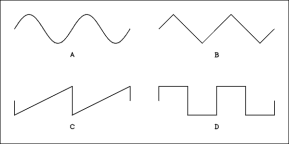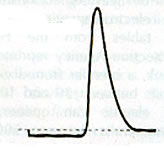Part
Two is also online
Page
1, 2
Different Shapes of Waves
As illustrated in the diagram of notes played by various instruments, waveforms
have different shapes. Figure 4 shows some common ones in their simplest
forms.
 Figure 4: Wave Forms Figure 4: Wave Forms
A: Sine
B: Triangle
C: Sawtooth
D: Square
The more complex an object,
the more frequencies it contains – also,
the more complex wave forms it will have. A useful analogy between
simple and complex forms is the difference between plucking a single
string
(which represents
a simple organism like an amoeba) and playing an entire orchestra
(which represents a complex organism like a human being).
Symmetry and Asymmetry: The Language
of Math and Music
The symmetry of music and the asymmetry of noise can also be described
mathematically. Mathematically, sound is comprised of random frequencies
that have little or
no relationship to each other. Mathematically, tones or music are comprised
of frequencies that do have relationships to each other. (A single, true
tone will naturally be in symmetry with itself.) The absence of certain
mathematical
relationships in sound and the presence of those relationships in music
explain why sound can irritate the nerves and music can calm them.
Although EM fields and sound transmit frequencies in different ways, the
mathematical measurements representing the relationship between electromagnetic
frequencies
are the same for music. Put another way, the harmonic relationships of
each system are governed by identical mathematics. The frequencies of musical
tones and the EM spectrum exist in octaves, higher harmonics, and lower
harmonics
of each other. Thus, musical tones and EM spectrum frequencies have mathematical
relationships to some of the other frequencies that are higher or lower.
For
example, a frequency that is multiplied or divided by two produces a higher
or lower octave of itself.
As with sound, EM fields possess symmetry and asymmetry. Various electromedical
devices can detect the equivalent of either noise or music in the oscillations
of cells and tissues in the body. When the oscillations are not mathematically
harmonious (which corresponds to noise), there is disease and degeneration.
When the oscillations are mathematically harmonious (which corresponds
to music), the cells function optimally and correctly.
Pulsed Magnetic
Fields
There are many ways to induce an EM field. One way is with magnetism.
Although magnetism per se exists in a static state, inducing movement
in a magnetic field creates a corresponding movement in the electric
field that naturally exists at right angles to it. The result is
electromagnetic radiation. When this type of EM radiation is created
from movement, it is commonly referred to as pulsed.
Pulsing a wave means that the signal is "on" for a brief
period, then off, then on, then off, etc. Pulsing is independent
of the frequency, which is equivalent to a note in music. The pulsing
is like the rhythm. Carrying the analogy further, a wave taking
up its full cycle of "space" is a whole note. A wave taking
up only half of that cycle is a half-note. A wave taking up only
one-quarter of that cycle is a quarter note, a wave taking up only
one-eighth of that cycle is an eighth note, and so on. Speaking
musically, the "on, off, on, off" aspect of the wave could
also be regarded as "note, rest, note, rest, etc."
Many of the pulsed magnetic fields that are used in electromedical
devices have a "rhythm" comparable to only an eighth note,
because the wave is "on" for only a brief period. But
that brief period is long enough to induce movement in the body.
The movement of the EM radiation in the body translates into ion
transport, increase in blood and lymph flow, and more. Any frequency
can be pulsed.
In Figure 5, the bottom line shows
a "lag time," or interval, when the wave is at rest, before
it resumes its upward-moving cycle.

Top: Peak of the waves.
Bottom: Time(duration) when wave is off.
Figure 6 shows
two waves in succession. Here, the "lag time" or rest
interval between the waves is easily seen. Note that there is no
trough to the wave because it has been truncated.

Top:
Peak of the waves.
Bottom: Time(duration) when wave is off.
Pulsed
electromagnetic radiation induces therapeutic results, which is why
it is used.
Some electromedical devices using pulsed EM fields will be discussed
later. The Electromagnetic
Body
Energy in Living Systems
Electromagnetic waves can be used for diagnostic purposes because living organisms
are energy-based. Historically, most cultures have erroneously regarded the
body solely as a mechanical and biochemical organism. But every cell in the
body is a transmitter and receiver of electromagnetic information. The following
are examples of how human beings, animals, and plants contain and respond to
EM fields:
- During migration, monarch butterflies, locusts, and even
blindfolded birds navigate flawlessly. Salamanders and turtles also
use magnetic fields to
navigate.
We now know that magnetite, a highly magnetic mineral, is found in the
tissue and brains of insects, birds, reptiles, and amphibians.
- Bacteria
use their magnetic sense to burrow deeper into the mud. We now
know that magnetite is also present in bacteria and protozoa.
- Many
kinds of fish are able to follow each other in organized formations
("schools")
due to the magnetic fields generated by the magnetite in their bodies.
- The
whiskers of dogs, cats, and other animals are now recognized
to function as antennas, due to their sensitivity to electromagnetic
fields.
- In plants, the sharp points of leaves, as well as pine
needles and the blades of some species of grass, act like antennas
for electrical
signals.
- Melatonin, a hormone that (among other functions) helps induce
sleep, is produced by the pineal only in darkness. We now know that
the
pineal gland, deep inside
the brain in the skull, is exquisitely sensitive to light.
- Stingrays find food because they can detect normal, minute amounts
of electrical discharge or magnetic fields emanating from their
prey.
- Fish, dolphins, and whales use both the earth's magnetic fields
and sonar (sound) for navigation and communication.
- The behavior
of some animals has long been used to forecast earthquakes. Cattle
stampede, birds sing at the wrong time of day, mother cats
move their kittens, snakes seek shelter. B. Blake Levitt writes: "It is
now thought that [the animals] are reacting to changes in the earth's magnetic
field,
as well as to electrostatic charges in the air – long
before the quake actually occurs or registers on even the
most sensitive instruments."2
In "The Electrical Properties of Cancer Cells,"3
medical doctor Steve Haltiwanger describes how the body partly functions
as
a living electrical circuit. Various cells and tissues are conductors
(allow for electron flow), insulators (inhibit electron flow), semiconductors
(allow for electron flow in only one direction), capacitors (accumulate
and store charge, later to release that charge), and so on. Cells transmit
and receive energy, and each has its very own frequency with which
it oscillates. Since magnetic and electrical waves exist at right angles
to each other, magnetic fields applied to the body also create biological
changes. We now know that in humans, the sinuses, some other bones
in the face, and various tissues in the body contain magnetite.
Not only is every cell in the body a transmitter and receiver of
electromagnetic information, it is these various electromagnetic
frequencies that precede and
correspond to biochemical functions. For example, healthy cells oscillate
at higher frequencies than do unhealthy cells like cancer. The lower
frequency
of cancer is reflected by (and causes) the aberrant biochemical reactions
within the cell. Put another way, the biochemical differences between
normal healthy
cells and cancer cells correspond to the differences in the electrical properties
of each. The same holds true for magnetic fields. Magnetic fields correspond
to biological activity. A change in the magnetic field means a change in
the cells, either positive or negative. Harmful Effects of EM Radiation and EM Fields
In the last century, medical doctor and stress pioneer Hans Selye observed
that when bodily tissues are subjected to repeated, intense input – whether
chemical (environmental pollutants, adrenal "fight-or-flight" hormones)
or mechanical pressure (bruising) – the body perceives it as stress.
It responds by tightening the envelope of membranous fascia that surrounds
the muscles. This, in turn, causes significant biochemical malfunctions,
not the least of which is the disruption of the cell membrane. Other stressors
that can disrupt cell integrity include the actual puncturing of the cell
membrane, and microbial infection. Cell permeability for the proper materials
is key. If glucose, other nutrients, and beneficial hormones cannot efficiently
enter the cell, and if wastes cannot completely exit, microbes can proliferate
and degenerative disease can occur. To Selye's list of stressors, I
would add destructive EM radiation and EM fields.
It has been known for decades that electrical fields can damage cells. B. Blake
Levitt writes:
Direct current (DC) is the steady flow
of electrons in one direction. Alternating current (AC) is an electron
flow that changes strength and alters
direction
within a certain cycle; the AC field collapses and reappears with its poles
reversed every time the current changes direction....Direct current creates
a steady magnetic field. But with alternating current, each time the direction
of the electrons is reversed, or flipped, a powerful magnetic field is created
that fluctuates at the same frequency.4
Another reason these fields are dangerous
is that the waves are coherent. Although the sun constantly transmits
naturally occurring radio frequencies,
microwaves
and other EM fields, this radiation is generally diffuse, whereas alternating
current is concentrated. Concentrated radiation is not natural. For example,
you need to purposely harness, focus, augment, and direct a bombardment of
electrons to turn on a light bulb. In Electromagnetic
Man: Health & Hazard
in the Electrical Environment, Cyril Smith and Simon Best write:
It
is just over 100 years since electricity generation started; 60 years since
radio transmissions and 40 years since radar and telecommunications
entered
our environment. [The book was published in 1990.] Like natural fields,
man-made fields are limited by the physical properties of the environment.
Unlike
natural fields, they are highly coherent and can interfere with our bio-signals.5
The
harmful effects of some EM fields are many and varied. Jacqueline
Krohn and colleagues explain that in the many studies
…
exposing cells and animals to ELF [extremely low frequency] fields…electric
workers and their children have a higher risk of brain tumors. The
incidence of childhood leukemia is higher in children who live near
power lines that
carry high voltage. Power-line exposure has also been associated
with an increased incidence of suicide.
These studies support the hypothesis that ELFs act as a cancer promoter.
ELF fields interact with the cell membrane and can affect hormones, calcium
exchange,
and tissue growth. It is postulated that the ELFs suppress the production
of melatonin, a cancer inhibitor, by the pineal gland.6
The effects of
ELF fields is more than mere "postulation," as
other researchers have corroborated. Smith and Best cite formal published
studies
linking the following maladies to extremely low frequency, electromagnetic
fields:
- Allergies
- Autoimmune disorders, such as lupus erythematosus
and multiple sclerosis
- Birth defects and genetic abnormalities
- Cancers of various types,
including brain tumors and leukemia
- Emotion and mood changes,
including higher percentages of suicides
- Eyestrain and headaches
- Fatigue and sleep disturbance
- Heart attacks
- Hormonal abnormalities
- Infectious disease increase
- Lowered fertility, miscarriages,
and pregnancy problems, including stillborn children
- Nervous system
disorders, including confusion, convulsions, dizziness, hyperactivity,
and memory loss
- Stress increase and intolerance7
The harm from EM fields and EM radiation
also depends on the proximity of the person, animal, or plant to the source
of the energy. A milligauss
is a unit of measurement of the strength of an electromagnetic field. According
to
tables from the Environmental Protection Agency reprinted in Levitt's
book,
a blender from six inches away emits between 30 and 100 milligauss;
an electric can opener six inches away emits between 500 and 1500 milligauss;
a hair
dryer
six inches away emits between one and 700 milligauss; and a ceiling
fan
12 inches away emits between three and 50 milligauss.8 Some sources
maintain that even two milligauss is enough to disrupt a person's
biological
function and that the maximum emission a person can safely absorb is only
one milligauss.
This is why there is a high rate of illness among people living
near major power lines, cell phone towers, electrical generators,
and similar
disruptors.
Healing Effects of EM Radiation and EM Fields
Considering the extent that artificially created, non-beneficial
EM radiation surrounds us, it is not surprising that (aside from
the contributing
factors of poor diet, pathogens, and chemical pollutants) so many
people are ill.
The good news is, if frequencies can harm, they can also be used
to heal.
Cells
have the ability to positively and healthfully respond to minute
electromagnetic stimulus – as long as certain criteria are met. The stimulus must be
from the correct region of the EM spectrum; it must further be refined (if
necessary) to an exact frequency or combination of frequencies on that EM band;
it must be the correct intensity; it must have the correct shape wave or wave
packet; it must be administered in the correct amounts; and, of course, it
must be accurately and precisely aimed at the target. In electronics, there
is a term that refers to the transfer of energy from one component to another
through a shared magnetic field: inductive coupling. In electromedicine, the
response of living cells to beneficial EM radiation is also called inductive
coupling. Once the EM fields inside a cell are exposed to EM radiation, the
fields within the cell start to move. Along with this energetic process, the
corresponding biochemical responses are activated, such as the movement of
electrolytes through the cell membrane, excretion of wastes, and so on. Inductive
coupling is being utilized in a growing number of extremely effective electromedical
devices.
Researchers are discovering that many of the beneficial effects
from electromedical devices come from pulsed magnetic fields (which
by
definition become electromagnetic
radiation). Pulsing a magnetic field does more than induce movement
in the body receiving the signal. Because pulsing by definition
means that
there
is an "off" period to the signal, it ensures that the human or animal
receiving the signal does not become resistant to its effects. A good analogy
is someone tapping your arm. At first you pay attention; but after awhile,
the body becomes impervious to the sensation so it can focus on other stimuli.
This is one of the secrets of electromedicine devices that are effective.
Correctly employed, frequency therapies can increase cell energy,
normalize membrane conductivity, lessen oxidative stress, reduce
the amounts
of inflammatory chemicals in the blood, improve protein synthesis,
boost
feel-good endorphin
levels, restore depleted adrenal function, and enhance immune function.
The restoration of these metabolic processes lead to the regeneration
of tissue
as well as resistance to disease.
"Bigger is better" and "More is better" figure prominently
in the Western mindset. The unbridled use of massive doses of many different
kinds of drugs and the routine practice of "prophylactic" invasive
surgery illustrate this mentality. Another, more humane edict – "Less
is more" – reflects what the body usually needs. The exquisite sensitivity
of cells to electromagnetic fields of all kinds explains why electromedical devices
work – and why the most subtle ones work the best. By "subtle," I
mean those energies that subjectively might not be easily perceived, but which
are the most compatible with living systems precisely because they are of lower
power.
Electromedicine therapies may use many portions of the EM spectrum:
electrical current, magnetism, visible light, far infrared (FIR),
ultraviolet (UV), and heat in the form of specific FIR wavelengths.
In Part Two
of
this article,
I will discuss some therapies that use various EM wavelengths.
Then I will explain sound as it relates to the EM spectrum, and explore
one use
of
sound for therapeutic purposes. © 2007 by Nenah Sylver, PhD Nenah Sylver, PhD
P.O. Box 74324
Phoenix, Arizona 85087-4324
nenah@nenahsylver.com
nenahsylver@cox.net
www.nenahsylver.com
Editor's Note: Part
Two of this article, including a full listing of Resources,
will appear next month.
Page 1,
2

Notes
1. Kovács R. Electrotherapy and Light Therapy
with Essentials of Hydrotherapy and Mechanotherapy. Philadelphia: Lea & Febiger;
1949: 310-311.
2. Levitt B. Electromagnetic Fields: A Consumer's
Guide to the Issues and How to Protect Ourselves. San Diego: Harcourt Brace & Company;
1995: 72-73.
3. Haltiwanger S. The electrical properties of cancer cells. Available
at: www.royalrife.com/haltiwanger1.pdf. April 2, 2006.
4. Levitt B. op cit: 47-48.
5. Smith CW, Best S. Electromagnetic Man:
Health & Hazard in the
Electrical Environment. London, England: J.M. Dent and Sons Ltd.; 1990:
45.
6. Krohn JF, Taylor A, Prosser J. The Whole
Way to Natural Detoxification: The Complete Guide to Clearing Your
Body of Toxins. Point Roberts,
Washington: Hartley & Marks Publishers, Inc.; 1996: 85.
7. Smith CW, Best S. op cit.
8. Levitt, B. op cit: 254-258.
|



![]()
![]()
![]()

 Figure 4: Wave Forms
Figure 4: Wave Forms
